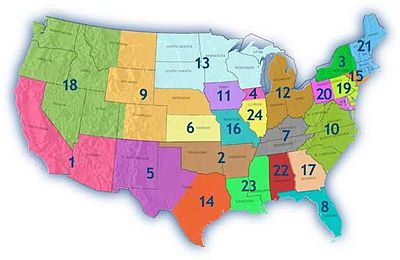- National Junior College Athletic Association
-
National Junior College Athletic Association 
Logo NJCAAAbbreviation NJCAA Motto Promote and foster Junior College Athletics on Intersectional and National levels! Formation May 14, 1938 (Intercollegiate Athletic Association) Legal status Association Headquarters Colorado Springs, Colorado Region served  United States
United StatesMembership 24 (Regions), 525 (Members) Official languages English Executive Director Mary Ellen Leicht Main organ Executive Committee Website www.NJCAA.org/index.cfm  Men and women Division III basketball championship trophies from 2003 at Suffolk County Community College
Men and women Division III basketball championship trophies from 2003 at Suffolk County Community College
The National Junior College Athletic Association (NJCAA), founded in 1938, is an association of community college and junior college athletic departments throughout the United States. It is held as Divisions and Regions. The current NJCAA holds 24 separate regions.
Contents
History
The idea for the NJCAA was conceived in 1937 at Fresno, California. A handful of junior college representatives met to organize an association that would promote and supervise a national program of junior college sports and activities consistent with the educational objectives of junior colleges.
The constitution presented at the charter meeting in Fresno on May 14, 1938, was accepted and the National Junior College Athletic Association became a functioning organization.
In 1949, the NJCAA was reorganized by dividing the nation into sixteen regions. The officers of the association were the president, vice president, secretary, treasurer, public relations director, and the sixteen regional vice presidents. Ironically, though the NJCAA was founded in California, it no longer operates there and has been supplanted instead by the unaffiliated California Community College Athletic Association (CCCAA) with 100+ colleges participating.
Division History
Years Division 1938-1945 None 1945-1986 Division I 1986-1991 Division I, Division II 1991-present Division I, Division II, Division III Awards
- Academic All-American by Sport
- NJCAA Academic Team of the Year by Sport
- BJ Graber Female Athlete of the Year by Sport
- David Rowlands Male Athlete of the Year by Sport
- Lea Plarski Award by Sport
- NJCAA Championship Ring National Sponsor by Sport
- NJCAA Service Awards by Sport
Conferences
- Region 1 Arizona Community College Athletic Conference
- Region 2 Bi-State Conference
- Region 3 Mid-State Athletic Conference, West New York Athletic Conference, Mountain Valley Athletic Conference (NY) (http://www.region3athletics.org/)
- Region 4 Illinois N4C Conference, Illinois Skyway Conference (http://www.illinoisskyway.org/), Arrowhead Conference
- Region 5 Metro Athletic Conference (NJCAA), North Texas Junior College Athletic Conference, Western Junior College Athletic Conference
- Region 6 Kansas Jayhawk Community College Conference
- Region 7 Tennessee Junior and Community College Athletic Association
- Region 8 Suncoast Conference
- Region 9 NJCAA Region 9, Mon-Dak Conference
- Region 10 Carolinas Junior College Conference
- Region 11 Iowa Community College Athletic Conference
- Region 12 Michigan Community College Athletic Association, Ohio Community College Athletic Conference
- Region 13 Minnesota College Athletic Conference, Mon-Dak Conference
- Region 14 Southwest Junior College Conference
- Region 15 Mid Hudson Conference
- Region 16 Missouri Community College Athletic Conference
- Region 17 Georgia Junior College Athletic Association
- Region 18 Northwest Athletic Association of Community Colleges, Scenic West Athletic Conference
- Region 19 Garden State Athletic Conference
- Region 20 Pennsylvania Collegiate Athletic Association, Maryland Junior College Athletic Conference
- Region 21 Massachusetts Community College Athletic Association
- Region 22 Alabama Community College Conference
- Region 23 NJCAA Region 23
- Region 24 Mid-West Athletic Conference, Collegiate Conference of Central Illinois
Sports
- Baseball (Divisions I, II, III)
- Basketball (Divisions I, II, III)
- Softball (Divisions I, II, III)
- Volleyball (Divisions I, II, III)
- Soccer (Divisions I, II)
- Track and Field (Divisions I, II)
- Tennis (Divisions I, II)
- Wrestling (Divisions I, II)
- Golf (Divisions I, II, III)
- Cross Country (Divisions I, II)
- Ice hockey (Divisions I)
- Football (Divisions I)
- Bowling (Divisions I)
- Swimming (Divisions I)
- Diving (Divisions I)
- Lacrosse (Divisions I)
- Half Marathon (Divisions I)
Football
Due to the relatively small number of schools fielding teams, some football-only conferences exist. They may be home to teams from multiple regions.
- The Kansas Jayhawk Community College Conference includes only schools in Kansas (Region 6). All are members of the conference in other sports.
- The Midwest Football Conference includes schools from Iowa (Region 11), northern Illinois (Region 4), Michigan (part of Region 12) and North Dakota (part of Region 13).
- The Minnesota College Athletic Conference, like the KJCCC, includes only schools in Minnesota (part of Region 13), all of which participate in the conference in other sports.
- The Mississippi Association of Community and Junior Colleges only includes schools in that state, which is a part of Region 23. None of the Louisiana members of Region 23 field a football team.
- The Northeast Football Conference includes schools from Region 3 (Upper New York), 15 (Lower New York, New York City and Long Island), 19 (Lackawanna, Pa.) and 21 (Dean, Mass.) Lackawanna and Dean are the only football-playing schools in their respective regions.
- The Southwest Junior College Football Conference includes teams from both regions in Texas (5 and 14) and one from Oklahoma (Region 2).
- Western States Football League includes teams from Arizona (Region 1), New Mexico (Region 5), and Utah (Region 18).
There are also independent schools in Regions 2 (Arkansas Baptist and Lon Morris), 10 (Louisburg, N.C.), 13 (Dakota-Bottineau), 15 (Globe Tech) and 17 (Georgia Military).
Regions 7, 8, 9, 16, 20, 22 and 24 do not have any football programs.
Basketball Championships
See also
- NJCAA National football championship
- List of Division 1 NJCAA schools
- List of Division 2 NJCAA schools
- List of Division 3 NJCAA schools
- California Community College Athletic Association (CCCAA)
- National Collegiate Athletic Association (NCAA)
External links and references

This article about a sports-related organization is a stub. You can help Wikipedia by expanding it.

